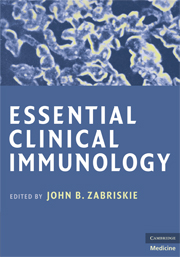Book contents
- Frontmatter
- Contents
- List of Contributors
- 1 Basic Components of the Immune System
- 2 Immunological Techniques
- 3 Immune Regulation
- 4 Immunological Aspects of Infection
- 5 Immunological Aspects of Immunodeficiency Diseases
- 6 Autoimmunity
- 7 Chronic Lymphocytic Leukemia
- 8 Immunology of HIV Infections
- 9 Immunological Aspects of Allergy and Anaphylaxis
- 10 Immunological Aspects of Skin Diseases
- 11 Experimental Approaches to the Study of Autoimmune Rheumatic Diseases
- 12 Immunological Aspects of Cardiac Disease
- 13 Immunological Aspects of Chest Diseases: The Case of Tuberculosis
- 14 Immunological Aspects of Gastrointestinal and Liver Disease
- 15 Immunological Aspects of Endocrine Disease
- 16 Immune-Mediated Neurological Syndromes
- 17 Immunological Aspects of Renal Disease
- 18 Immunological Aspects of Transplantation
- Index
13 - Immunological Aspects of Chest Diseases: The Case of Tuberculosis
Published online by Cambridge University Press: 18 December 2009
- Frontmatter
- Contents
- List of Contributors
- 1 Basic Components of the Immune System
- 2 Immunological Techniques
- 3 Immune Regulation
- 4 Immunological Aspects of Infection
- 5 Immunological Aspects of Immunodeficiency Diseases
- 6 Autoimmunity
- 7 Chronic Lymphocytic Leukemia
- 8 Immunology of HIV Infections
- 9 Immunological Aspects of Allergy and Anaphylaxis
- 10 Immunological Aspects of Skin Diseases
- 11 Experimental Approaches to the Study of Autoimmune Rheumatic Diseases
- 12 Immunological Aspects of Cardiac Disease
- 13 Immunological Aspects of Chest Diseases: The Case of Tuberculosis
- 14 Immunological Aspects of Gastrointestinal and Liver Disease
- 15 Immunological Aspects of Endocrine Disease
- 16 Immune-Mediated Neurological Syndromes
- 17 Immunological Aspects of Renal Disease
- 18 Immunological Aspects of Transplantation
- Index
Summary
INTRODUCTION
The respiratory tract is one of the first portals of entry for many viral and bacterial microorganisms. The local defense systems are generally sufficient to handle most invading microorganisms in healthy individuals but if the lung is damaged by bronchiectasis or fibrosis, the infecting microorganisms are able to establish an infection, cross the epithelial layer, and cause invasive disease.
The respiratory tract has two main compartments. The first is the airways, which extend from the nose to the terminal bronchioli. The second area is the alveoli in the lung tissue. The airways' defenses include many features such as ciliary movement, mucus, antimicrobial proteins, and rapid arrival of neutrophils whose combined action make it difficult for organisms to establish an infection. The access to the alveoli is also generally limited to very small inhaled particles. In the alveoli, invading microorganisms encounter resident alveolar macrophages that play a major role in engulfing and killing invaders.
The lung has its own immune system, which is known as bronchus-associated lymphoid tissue. Antigen-specific immune responses are generated at these sites, which, similarly to the Peyer's patches in the intestine, contain dendritic cells (DCs), which are the main antigen-presenting cells, as well as T and B cells, the latter organized into B-cell follicles, as well as macrophages. Immune responses occur in response to infections or injury to the tract. The main antibodies found in respiratory tract secretions are IgA and IgG. However, B cells producing IgE and IgG are also found in the lung.
- Type
- Chapter
- Information
- Essential Clinical Immunology , pp. 231 - 250Publisher: Cambridge University PressPrint publication year: 2009

